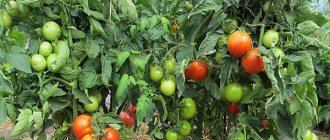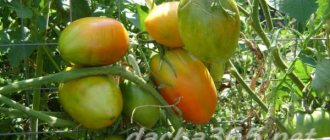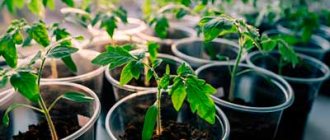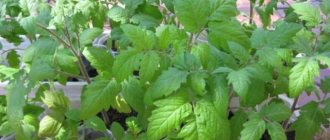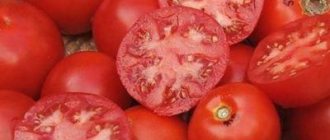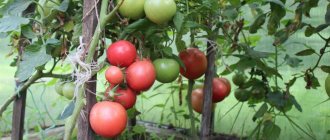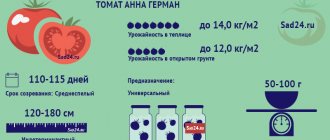| Ripening period: | early |
| Fruit shape: | heart |
| Color: | crimson |
| Weight: | 0.25 kg |
| Productivity: | 5-8 kg per square meter |
The determinate tomato Velmozha is an early ripening variety of Russian origin. Along with high yield, tomatoes are characterized by good adaptation to growing conditions. Plants can be planted in greenhouse buildings, greenhouses and outside shelter without loss of productivity. It is worth taking a closer look at the varietal data, the positive and negative aspects, and the subtleties of planting.
Characteristics and description of the variety
Mostly varietal tomatoes grow well in warm areas, but do not withstand the cool climate of the north of the country. One of the frost-resistant species is the Velmozha tomato, the characteristics and description of which were included in the State Register in 2005. Optimal regions for cultivation:
- Siberia;
- Ural;
- Far East.
Plants of this variety:
- grow up to 0.7 m without shelter, up to 1.4 m in a greenhouse;
- require tying due to weak stems;
- need to form a bush;
- have complex inflorescences every 1-2 leaves, starting from 7;
- ripen in 103-117 days.
The variety is not suitable for cultivation on an industrial scale, but has good performance in summer cottages or garden plots in closed and open ground.
Fruit
Velmozha tomatoes are large-fruited varieties. Seed nests in fruits of 4 or more, with a small amount of moisture. The seeds have time to ripen and retain all the properties of the variety. The pulp of tomatoes is dense and fleshy, with almost no voids in the cut.
The appearance of the fruit resembles a heart with a wide top and a sharp elongated end. The shape resembles the tomatoes Pudovik, Alsou, and Bull's Heart.
Tomatoes ripen in bunches, each of which contains up to 10 pieces. The durable raspberry-colored peel is not prone to cracking.
Tomatoes store well and do not lose their shape during transportation. In addition, tomatoes have an attractive shape and uniform size, as can be seen from the photo of the fruit.
Taste qualities
The main advantages of the Velmozha variety relate not only to large fruit, but also to taste. Tasting rating of tomatoes 8.6 out of 10. The pulp of the fruit has a rich, bright taste. The sugar content of a tomato is 3-4.5%, which is facilitated by its low acid content.
The bright taste of the fruit is preserved even after processing, thanks to the large amount of dry matter in the range of 4-6%.
Productivity
According to reviews of the Velmozha tomato, the smallest fruits weigh no less than 150 g, and the largest ones grow to a record 800 g. Although most tomatoes have similar sizes and an average weight of about 250 g.
According to agricultural data, when growing tomatoes in the Urals and Siberia, you can get about 0.4 tons of fruit per hectare of plantings. The yield of Velmozha in the middle zone reaches 0.7 tons. High-quality fruits make up 95% of the total harvest.
Usage
Based on the reviews, we can draw a conclusion about the scope of application of Velmozha tomatoes:
- Large, uniformly sized tomatoes are suitable for canning due to their dense flesh and tough skin.
- The low free liquid content and pleasant taste allow the fruits to be used in salads and fresh snacks.
- A high proportion of dry matter is optimal for processing tomatoes into pastes, sauces or ketchup.
The low acid content in combination with vitamins and minerals allows the crop to be used for preparing baby food or diet food.
Harvesting and storing tomatoes
Harvesting is recommended in warm, sunny weather. The collected fruits are sorted, placed in suitable containers and stored in a cool place.
Ripe vegetables are recommended to be consumed fresh and used for preparing vegetable salads, stews, sauces, tomato paste and ketchups. But large fruits are not suitable for canning.
Growing seedlings
Seeds for planting can be purchased at the store, and subsequently prepared independently.
The Velmozha tomato variety is not a hybrid variety, so the seeds of the fruit retain all the properties of the plant. When purchasing, you should pay attention to the expiration date and information on the packaging.
Before planting, seeds should be inspected for plaque or damage, and defective ones should be removed.
Disinfection of the material is carried out by soaking in a weak solution of hydrogen peroxide or potassium permanganate.
You can improve the resistance of the Nobleman through the hardening procedure, for which the seeds are placed in the refrigerator or freezer for 12 hours, and then returned to room temperature for 12 hours.
For planting seedlings, you can use any universal soil composition rich in nutrients. The store-bought mixture can be placed in containers immediately, and manually prepared soil should be disinfected with boiling water 10 days before planting the seeds.
Both wooden and plastic containers are suitable for seedlings.
Seed material is planted 2 months before the planned move to a permanent place. The seeds are planted in moist soil in holes 1 cm deep, one at a time at a distance of at least 4 cm from each other, after which they are sprinkled with soil. The container is covered with transparent material and placed in a warm place with diffused light. The cover is removed after 14 days. If there is a lack of natural light, it is worth installing additional fluorescent lamps.
An important condition for the growth of seedlings is proper care. Plants need not only warmth, but also maintenance of soil moisture. Watering must be done carefully so as not to damage the noble sprouts.
14 days after the emergence of seedlings, additional fertilizers can be added to the soil. It is advisable to use nitrogen compounds that provide rapid growth of green mass. If necessary, fertilizing is carried out weekly.
Recommendations for growing the Velmozha variety
It is preferable to grow tomatoes of the Velmozha variety in seedlings; prepared seeds are sown for this at the end of March. The soil can be used on the basis of turf soil, or you can also mix sand or peat into it, depending on the preferences of the vegetable grower himself. You can also add some mineral fertilizers to the total mass, which also have an excellent effect on the general condition of the plant, on fruit set and on their formation.
When sowing, it should be taken into account that the gardener must make a drainage layer from expanded clay or broken brick. In order for Velmozh tomato seeds to germinate faster, it is also necessary to place the containers in a warm, dry place, cover the top with polyethylene or glass to create the required level of humidity. After the shoots appear, it is necessary to move the containers to a well-lit surface. The air temperature should not exceed +17 degrees. After another place, the containers are placed in an even warmer environment - there the temperature should be about +22 degrees. As soon as about five formed leaves appear on the seedlings, it is necessary to plant the plants in isolated containers, which can be plastic or peat. Seedlings are fed approximately three or four times with mineral mixtures, and you can also use organic matter for feeding; it also has an excellent effect on the growth and formation of the plant and its root system. You can use manure solution, wood ash.
In general, the Velmozha tomato variety is an excellent hybrid species that pleases vegetable growers not only with large, but also very tasty fruits. In order to get a bountiful harvest, it will be enough to take care of the plants from the very first day, as well as carefully select the seeds for planting. The resulting fruits are ideal for fresh consumption, for preparing salads or sauces. Preparations for the winter can also be prepared from these fruits; they give an excellent taste both when salted and when pickled.
Landing in the ground
Velmozha tomatoes can be planted in open or closed ground. The growing method affects the height of the plants and the speed of fruit ripening.
It is advisable to choose a plot for tomatoes in such a way as to maintain proper crop rotation. The best precursors for culture are:
- legumes;
- cucumbers;
- carrot;
- onion;
- garlic.
It is important to choose the right soil composition or improve the soil using additives. Before planting, the soil needs to be loosened and the following added:
- rotten compost;
- wood fly ash;
- wet sawdust;
- fertilizers with phosphorus and potassium.
It is recommended to dig up the garden for Velmozha tomatoes 5-6 days before planting the seedlings, so that the soil is well mixed and settled. To disinfect, you can pour boiling water over the beds with the addition of a solution of copper sulfate.
Depending on the climate, Velmozhi seedlings are planted in a permanent place in May or June. In closed ground conditions, the period can be shifted by 2 weeks.
The plant placement pattern should not be dense; no more than 3 bushes should be planted on each square meter. The holes are placed at a distance of 0.4 m, and at least half a meter of free space is left between the beds. The planting depth is selected in accordance with the volume of the roots, which on average is 6-8 cm.
Characteristics of Velmozha tomatoes
Also check out these articles
- A fuel dispenser is an integral attribute of a gas station!
- Vietnamese pot belly pig
- Barbesier chicken breed
- 5 main mistakes when growing seedlings
Velmozha tomatoes have many positive qualities, but there are also disadvantages. All of them are collected in the characteristics of the variety.
- The plant adapts well to different climatic conditions, which is why it is grown in different regions. But if in the southern regions this variety is mainly planted in open ground, then in the northern regions it is grown in greenhouses.
- The fruits are large, beautiful, commercial type.
- There is a tendency to crack on bushes or when storing crops.
The pulp is very tender and juicy
- Resistance to cold snaps and short frosts.
- Strong immunity to many diseases. But there is a susceptibility to brown spot.
- Transportability is poor. On the road, ripe fruits become wrinkled, spoil, and crack. Unripe tomatoes are usually collected for sale - green fruits are denser and suitable for transportation.
Important!
Lack of heat and coolness do not affect the quantity and quality of fruits. Thanks to this quality, the Velmozha variety can be grown not only in the south, but also in the northern part of Russia.
Features of care
As Velmozha tomatoes grow, they require compliance with watering standards and care rules, including:
- regular loosening of the soil;
- weed removal;
- fertilization;
- bush formation;
- pest protection;
- disease prevention.
Watering
Velmozha tomatoes need regular, abundant watering throughout the growing season to gain green mass, as well as to form a harvest. Large-fruited tomato varieties are especially demanding of moisture during the period of weight gain. Uniform watering has a positive effect on the shape of the fruit. It is enough to perform the procedure once a week, increasing the frequency only during heat or drought.
For normal growth of tomatoes, a bucket of warm water for each square meter of planting is enough. The temperature of the liquid should not be low, preferably within 22-24°C. And during ripening, when the skin of the fruit begins to turn red, the volume of moisture should be reduced.
After each watering, it is recommended to loosen the soil. This procedure accelerates the delivery of water and oxygen to the roots of the tomato. To keep the soil moist, the beds can be mulched with peat or hay.
Stepsoning
The tomato variety Velmozha definitely needs pinching. First of all, you should remove the stepsons located under the brushes before flowering begins. The growth of these shoots takes away nutrients, which causes the inflorescences to die before the ovaries form.
The branches should not be pulled out; it is better to break them evenly or cut them with a garden tool, keeping the short stump. In this case, a new shoot will not be able to appear at the cut site.
The Velmozha variety is characterized by intensive growth of green mass, which leads to the constant appearance of new branches and leaves that will have to be removed throughout the growing season.
Bush formation
Proper plant formation significantly increases productivity, increases yield and allows the tomato to gain more weight. The bush must be freed from lower daughter shoots and excess foliage. The procedure is carried out before the formation of buds begins; at a later time, this will lead to the slow formation of ovaries.
For plants to be grown in open ground, 1 stem is retained; in greenhouses, 1-2 are left. Towards mid-August, you need to pinch the top of the bush to limit growth. In this case, the main energy of the plant will be directed to enlarging the fruits. At the same time, you can cut off the brushes on which the ovary is missing, since tomatoes will no longer appear there in the future.
Velmozhi bushes must be tied up, as the fragile shoots easily break under the weight of heavy fruits. Pegs up to 1.5 m high are installed at a distance of 8-12 cm from the center of the hole when planting seedlings in a permanent place.
Fertilizers
In order to grow a large and high-quality harvest of Velmozha tomatoes, you will have to take care of the constant application of fertilizers to the soil. The crop is demanding on nutrition and quickly depletes the soil. Recommended feeding schedule:
- On the 14th day after planting the seedlings, a universal fertilizer containing potassium and phosphorus should be applied.
- When the first pair of inflorescences appears, superphosphate and potassium sulfate should be added to the same preparation.
- At the time of flowering of the third cluster, the universal remedy is combined with nitrophoska.
- It is recommended to do the last feeding after 2 weeks. It is enough to add a little superphosphate to the soil.
During prolonged heavy rains, Velmozha in open ground should be protected from excess moisture. To do this, you can use a preparation for roots - “Kornerost”. Application of any type of fertilizer should be stopped 2 weeks before the start of harvest.
When growing the Velmozha variety in a greenhouse, fertilizers are applied in spring and autumn when digging the soil. And also once every 2 years the soil is completely replaced with a new one.
Planting tomatoes Velmozha
We recommend reading our other articles
- Ear mites in rabbits - signs and treatment
- How to increase egg production of chickens
- Grape variety Long-awaited
- Strawberry variety Kimberly
The easiest way to grow Velmozh tomatoes is using the seedling method. Seeds are sown in boxes with soil around March. The seeds are laid out directly on top of the ground and covered with peat no more than 1 cm. After this, the ground is watered, the box is covered with film and placed in a warm place (+25 degrees).
When shoots appear, the film must be removed and the seedlings placed in a bright place. The temperature should be about +16 degrees so that the seedlings do not stretch too much. After a week it can be increased to +20. Picking in individual containers is carried out when 2 leaves appear.
Seeds are sown in boxes with soil around March.
When the seedlings are 2 months old (6-7 leaves), you can begin to look for a final place for growing. It should be bright, spacious and not swampy. The soil is dug up in advance, mixed with fertilizers, and loosened. The Velmozha variety bushes produce large yields of large tomatoes. To do this, they require a lot of food and space. Because of this, thickening plantings is highly not recommended. The bushes are planted so that there are approximately 3 plants per square area.
Important!
When planting a tomato, you can add a little wood ash or humus to the holes to increase the nutritional value of the soil if it has not been fertilized in advance.
Diseases and pests
The main disadvantages of Velmozha tomatoes are the variety’s susceptibility to pest attacks. It is quite difficult to pre-protect tomatoes in open ground from insects. Spider mites pose a danger to plants. The pest eats leaves, young shoots and ovaries, which can even lead to the death of the bushes. The easiest way to get rid of this insect is to treat it with soapy water. But in case of extensive infestation, it is better to add mild insecticidal preparations.
One of the advantages of the Velmozha variety is good immunity developed over years of selection. But still, a tomato can be infected with infections such as:
- Late blight. The most common disease of cultivated plants leads to serious infection and loss of the crop. Fungal spores fall on plants with gusts of wind, penetrate inside the stems, and infect leaves and fruits with dark spots with a white coating. You can save plants by spraying with a solution of potassium permanganate, an infusion of tobacco leaves, or fungicides.
- Brown spot. After prolonged rainfall or due to excess watering, the bushes may become covered with brownish-red spots. To eliminate the problem, you need to equip drainage grooves for water, and also spray the plants with an infusion of garlic or wood ash.
- Verticillium. The disease leads to lethargy or yellowing of the lower leaves, which weakens the growing season and inhibits the development of fruits. Damaged areas need to be removed, and the roots of the tomatoes should be watered with a solution of nitrogen fertilizers.
Preventive measures to combat insects and diseases:
- compliance with the water regime;
- weed removal;
- providing sunlight.
Productivity
Practice has shown that the yield of the Velmozha tomato depends on the region of growth. In a test conducted in the Omsk region, 780 centners of tomatoes were harvested from 1 hectare, and in the Urals only 583 centners/ha. The yield of marketable products is high (95%) and does not depend on the region.
Statistics from dacha experiments show that with good care, 7-8 fruits weighing 180-600 g are removed from the bush. Larger fruits are grown by summer residents who ration the harvest. They remove some of the flowers. Impressive specimens weighing up to a kilogram are obtained only with the use of fertilizers. Fertilizers can be either organic or mineral.
Advantages and disadvantages of the variety
The main advantages of the Velmozha tomato according to reviews and photos:
- Tomatoes are endowed with juiciness and bright taste.
- Large fruits are not prone to cracking.
- Universal use of the crop in cooking.
- Low temperature resistance.
- Rapid adaptation of seedlings to growing conditions.
- Short growing season.
- The fruits retain their appearance and density during short-term storage and transportation.
- The seeds contain complete genetic material and are suitable for planting next year.
Among the disadvantages, Nobles note:
- During growth, the bushes require constant pinching.
- Weak stems cannot support the weight of tomatoes and therefore need support.
- Susceptibility of the variety to some fungal infections.
- High requirements for the composition and nutritional value of the soil, as well as access to moisture and oxygen.
Harvesting and processing
Velmozha tomatoes are harvested after the fruits ripen, when they turn bright crimson. At the same time, gardeners note that fruits can hang on the branches for a long time and not spoil. This does not affect the taste. The only risk is possible cracking.
Velmozha tomatoes can also be used for winter preparations
The harvest can be used for fresh consumption, salads, and snacks. The fruits are also suitable for processing. They are put in soups, borscht, and main courses. Can also be used for winter preparations (borscht dressings, ketchups, sauces, juices). But this variety is not suitable for canning in its entirety, because the tomatoes are very large and simply do not fit into the neck of the jar. And when salted in barrels, they literally fall apart.
Advantages and disadvantages
The disadvantages were noted above - poor keeping quality and transportability. It’s worth talking about the advantages of the Velmozha tomato. The first and important advantage is stable immunity to late blight and other fungal diseases. A set of preventive measures allows you to get a healthy tomato harvest even in problem years.
An undoubted advantage is versatility when choosing a place of growth. The tomato grows well both in protected soil and in the garden on a regular ridge. The main value is the fruits and their characteristics:
- size;
- taste;
- appearance.
The variety is of interest to tomato fans who collect their seeds. Velmozha tomato seeds can be obtained from your own tomatoes, used for further propagation, and shared with friends.
For greenhouse cultivation of Velmozhi, seeds are sown for seedlings in the very first days of April. Before emergence, you need to maintain the room temperature at about 25 °C, then lower it to 15 °C. The appearance of 6-7 leaves on the seedlings indicates its readiness for transplanting. For healthy seedlings, this moment occurs approximately 60 days after emergence.
For the good development of tomato bushes and their intensive fruiting, soil plays a great role. In practice, it has been proven that the best results are achieved by those who plant the Velmozha variety in areas with highly fertile, light soil. Only summer residents who have not carried out pre-planting soil preparation can be dissatisfied with the yield.
When choosing a place for a tomato garden, you should, if possible, adhere to the rules of crop rotation. Plant the Velmozha tomato where peas, beans, beans, carrots, cabbage, onions, and cucumbers grew last year. In greenhouses, the top layer of soil must be replaced every 2 years and its fertility restored annually. Every year, when digging, add the following to the soil:
- humus or compost - at least 4 kg/sq. m;
- old, aged sawdust – 3 kg/sq.m. m;
- superphosphate – 1 tbsp. l;
- ash – 1 tbsp.;
- potassium sulfate – 1 tbsp. l.
The beds are prepared 5 days before tomato seedlings are planted on them. Before digging, pour the soil well with hot solution. To prepare 10 liters of solution, the following are suitable: copper sulfate, copper oxychloride. You need to dissolve a tablespoon of any drug in water. The norm for watering is 1 l/sq.m. m. Sprinkle organic and mineral fertilizers in an even layer on the spilled soil and dig up to a depth of 30 cm.
When planting seedling bushes in open ground or in a greenhouse, you need to follow the advice of experts. Place no more than 3 tomato bushes per square meter. Sufficient feeding area and uniform illumination of the entire trunk and leaves contribute to good yield. Pour 1 liter of “Kornerost” stimulant solution into the wells.
Plant the seedlings vertically, deepen the stem by 8 cm. The variety is determinate, low, so you can leave 50 cm wide passages between the rows. Supports for the Velmozha tomato are necessary, the fruits are large, they load the bush well. The stakes are placed during the process of transplanting seedlings.
During the period of fruit formation, add phosphorus and potassium to the soil in the form of potassium fertilizers, or use the easy-to-use water-soluble preparation “Agricola Vegeta”. During the entire growing season, it is enough to carry out 3 to 4 full-fledged feedings. The feeding scheme given in the table has proven itself well.
| Feeding number | Stage | Quantity per 10 l | Drug name |
| first | 2 weeks after landing on the ridge | 1 tbsp. l | "Universal dew" |
| second | when the second flower cluster blooms on the Nobleman’s bushes | 1 tbsp. l, 1 tbsp, 1 tsp | Agricola Vegeta, superphosphate, potassium sulfate |
| third | When does the 3rd flower cluster begin to bloom? | 1 tbsp. l, 1 tbsp. l | "Agricola Vegeta", nitrophoska |
| fourth | 2 weeks after the third | 2 tbsp. l | superphosphate |
The Velmozha tomato loves abundant watering from 10 to 20 liters per square meter. m. The frequency of watering directly depends on the weather. The recommended frequency is 1 watering every 6 days. It is better to sprinkle the top layer of soil with mulch: peat, compost. A layer of mulch 2 cm thick protects the soil from overheating, drying out, and the formation of cracks and crusts.
In open ground, feed the Velmozha tomato with the “Kornerost” stimulant if there are prolonged rains. The stimulator prevents diseases of the root system, which are caused by excess moisture. For 1 sq. m of ridge you need 4 liters of solution prepared from 10 liters of water and 3 tbsp. l "Kornerosta".

